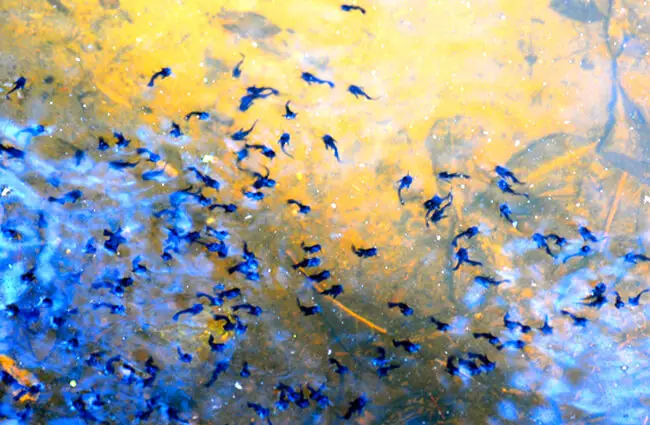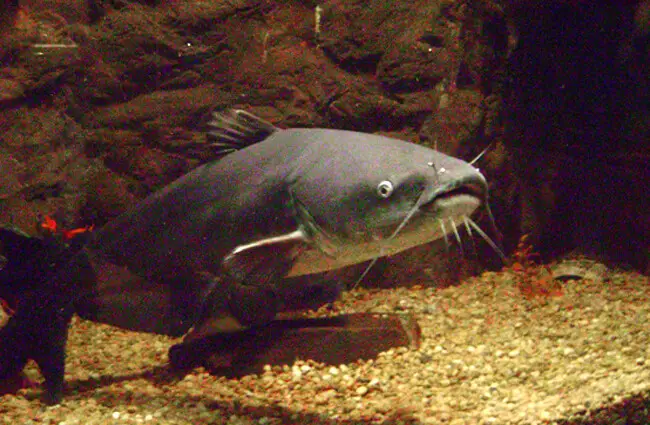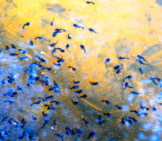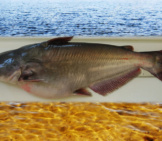The Blue Catfish is a species in the large taxonomic order Siluriformes. The Siluriformes order contains the thousands of different species of catfish on Earth. Some of its closest relatives include the bullhead catfish, channel catfish, and more. It is the largest species of catfish in North America. Read on to learn about the Blue Catfish.
Description of the Blue Catfish
Despite the name, this species is not drastically blue in color. Instead, its skin has more of a dark grey-blue coloration. Additionally, the skin on its sides has a silver coloration, and the underbelly is white. Like all catfish, it has whisker-like barbels, or fleshy growths, on its face.
This species reaches impressive lengths. Adults measure anywhere between 2 and 5 ft. long, and weigh up to 100 lbs. or more. However, the average individual measures about 2 ft. long and weighs about 5 lbs.
Interesting Facts About the Blue Catfish
This fish species is popular with anglers for its large size. Learn more about what makes this catfish unique, below.
- Close Cousins – This species shares North America with several other catfish species, including the flathead catfish and the channel catfish. It shares the same taxonomic genus with the channel catfish.
- Differentiation – In fact, many people cannot tell the difference between the blue and the channel catfish. This is no surprise, as the closely related species look incredibly similar. The only sure-fire way to differentiate between the two is by counting the spines on their anal fin.
- Invasion in Chesapeake Bay – People introduced this species to the Chesapeake Bay, where they have become an invasive species. However, though they do feed on native species, this fish actually preys more frequently on Asian clams, another invasive species.
- Sensitive Barbels – These fish use their whisker-like barbels to “taste” the water around them. The highly sensitive barbels help them search for food in murky waters.
Habitat of the Blue Catfish
This versatile species occupies primarily freshwater habitats. However, they can also live in brackish water ecosystems with a mixture of fresh and saltwater. They prefer habitats with deep waters and flowing currents.
While their preferred ecosystems have sandy bottoms, they also enjoy areas with piles of rocks to shelter near. Some of the different types of habitats that they occupy include deep rivers, lakes, streams, estuaries, and more.
Distribution of the Blue Catfish
You can find this species throughout a wide range of freshwater habitats in North America. They live along the eastern coast of Mexico up into Texas and to the Mississippi River Basin. Humans have also introduced this species to South Carolina, Virginia, Illinois, and more. In the Chesapeake Bay region, people consider this fish an invasive species.
Diet of the Blue Catfish
These fish have primarily carnivorous feeding habits, which means that they eat other animals. Their diet changes based on their age and where they live. Smaller individuals eat mostly plankton and other tiny organisms. As they grow, they prey on insects, worms, larvae, clams, and small fish. Adults hunt for fish, frogs, clams, insects, and more.
Blue Catfish and Human Interaction
Humans utilize this species for both recreational and commercial fishing practices. In fact, in regions where these fish grow quite large, they can sustain tourism for fishing purposes. Some people eat these fish, and some practice catch and release. With their high reproductive rate and swift growth, their numbers remain stable and the IUCN lists the species as Least Concern.
Domestication
Humans have not domesticated this fish in any way.
Does the Blue Catfish Make a Good Pet
No, people do not keep this catfish species as a pet. They grow much too large to keep in home aquariums.
Blue Catfish Care
Some aquariums house these large fish in their collections. They keep the fish in immense tanks with other catfish and compatible species. The aquariums also provide a number of large branches and similar structures for the fish to shelter near. Their diet consists primarily of fish, crabs, and shellfish.
Behavior of the Blue Catfish
These fish have social behavior, but they do not school in large numbers like some other species do. Groups have dominance hierarchies and fight with one another quite frequently. During the day, the fish remain in deep water away from the current. As night falls, they move to swiftly moving water to hunt for prey.
Reproduction of the Blue Catfish
When they reach about five years of age, these fish begin to reproduce yearly. The male builds a nest, and uses pheromones to attract a female. The female chooses the male with the best nest to lay her eggs in. After she has laid her eggs, the male fertilizes them.
Larger females lay more eggs, and the average clutch contains about 10,000 eggs or so. It takes between 3 and 6 days for the eggs to hatch. The male guards the nest and the young when they emerge. He continues to guard the nest until the young reach independence in a week or so.











![Red Angus Closeup of a beautiful Red Angus cowPhoto by: U.S. Department of Agriculture [pubic domain]https://creativecommons.org/licenses/by/2.0/](https://animals.net/wp-content/uploads/2020/03/Red-Angus-4-238x178.jpg)












![Red Angus Closeup of a beautiful Red Angus cowPhoto by: U.S. Department of Agriculture [pubic domain]https://creativecommons.org/licenses/by/2.0/](https://animals.net/wp-content/uploads/2020/03/Red-Angus-4-100x75.jpg)

